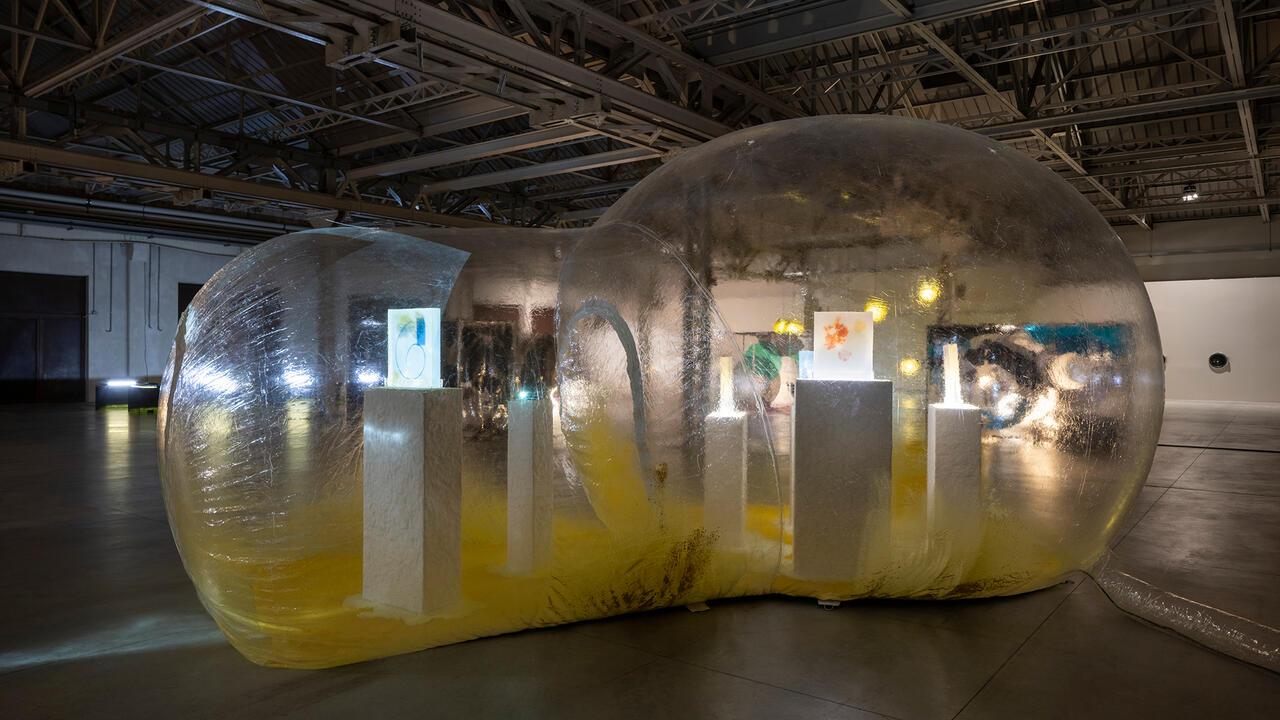Chatbots, tongues, denial & various other abstractions
Bortolami, New York, USA
Bortolami, New York, USA

We often look to artists to handle the strange materials of our age, to demonstrate a coming-soon Tomorrowland to a world in need of some assistance. In ‘Chatbots, tongues, denial & various other abstractions’ – a four-person exhibition including work by Cheng, Melanie Gilligan, Carissa Rodriguez and Anicka Yi – we were offered four alternative previews of our futures. As with the future, the exhibition never quite arrived. Whether we would ever want it to is another question.
The show opened with four lightbox display units by Yi, inlaid into the wall at varying heights in Bortolami’s entrance space, creating the impression of an aseptic lobby environment. In The Easy Way to Quit New York (2013), a large block of clear-ish glycerin soap encases a petri dish and scraps of paper, displayed alongside a red piece of Perspex affixed with a shower handle, wrapped in a ring of vinyl tubing. Engraved into the handle are two speech bubbles from an abstruse iPhone text exchange – ‘Do we need couple’s therapy?’ ‘No, we ARE couple’s therapy’ – which locates the work in a struggling romantic relationship. As did the title of the container next to it, It Only Takes 22 Minutes to Shift the Blame (2014). Looking at Yi’s works, we scan the bodily care items for the relics of a relationship: discontent that might have bred like invisible germs, a flicker of a dirty look shot in the mirror as two people brushed their teeth. Still, these objects, self-contained and cleanly, carefully arranged, resist such interpretations as much as they invite them. The unit nearest the floor, Mimetic Peanuts (2013), spilled over with dried dog food.
Personal health was also alluded to in the main gallery space by Rodriguez’s supersized photo prints of tongues (It’s Symptomatic/What Would Edith Say, 2014) annotated in black permanent marker by a practitioner of Eastern medicine. In this analysis these large, flat, alien-like organs, covered in green gunk, frills and cracks, revealed signs of stress, lack of care, illness or abuse. But the works also suggested an increasing interest in monitoring and quantifying the performance of bodies made strange to themselves – like meat, material or fabric. A more interiorized form of abstraction was found in Gilligan’s HD video work, 4 x exchange / abstraction (2013). Shown across four monitors, these fragmentary, trailer-like pieces had the most significant presence in the exhibition. Continuing the artist’s research into capitalism’s affective dimensions, these language-free, visual exercises were a departure for the usually articulate Gilligan. A pretty, businesslike woman is seen exchanging objects by a motorway, walking through a hotel lobby, driving a car, pulling stagey faces of surprise and so on, as though performing for camera. Commercially photographed objects, such as vases and trophies, are occasionally pictured flickering in the image, as though revealing a deeper coding to her actions (the objects were also shown flashing in lenticular prints around the space). On each monitor the woman’s image is subject to various hackneyed visual tricks: bludgeoned by data-moshing or flipped and moved using standard-issue editing graphics. Clips from three monitors were combined into a recap with an optimistic acoustic guitar soundtrack in the fourth video. The woman places the vases, trophies and so on in a bath full of water, smiling confidently as she goes about her nonsensical task. Life is reduced to object relations and image grammars; some fundamental element of a thing we would call humanity appears to have gone missing.
The exhibition’s coda was found in the back room in Cheng’s ‘live simulation’ Baby feat. Ikaria (2013), an animation and soundwork of infinite duration that features ‘intelligence services’ on its list of materials. As in Cheng’s previous works, fragments of digital animations replicate and swirl aimlessly, following an algorithmic logic on a large white screen (this one tall and thin and leaning at an angle). The images rendered here appeared to be urban or work-related – office phones and lampposts – accompanied by the randomly occurring acoustic of girlishly voiced chatbot talking to itself. ‘Are you free?’ she asks. ‘No but yes,’ she answers. Given what we have seen in the previous spaces, it’s difficult not to sympathize with her. On leaving, I was relieved to return to Yi’s lobby, an installation that now seemed like a selection of artefacts guarding the entry to a mausoleum. The meeting of bodies and objects here, fragments held in glycerin soap like the archetypal mosquito in amber, at least contained the sense that two humans had touched each other once. Or had at least had an iPhone conversation.























